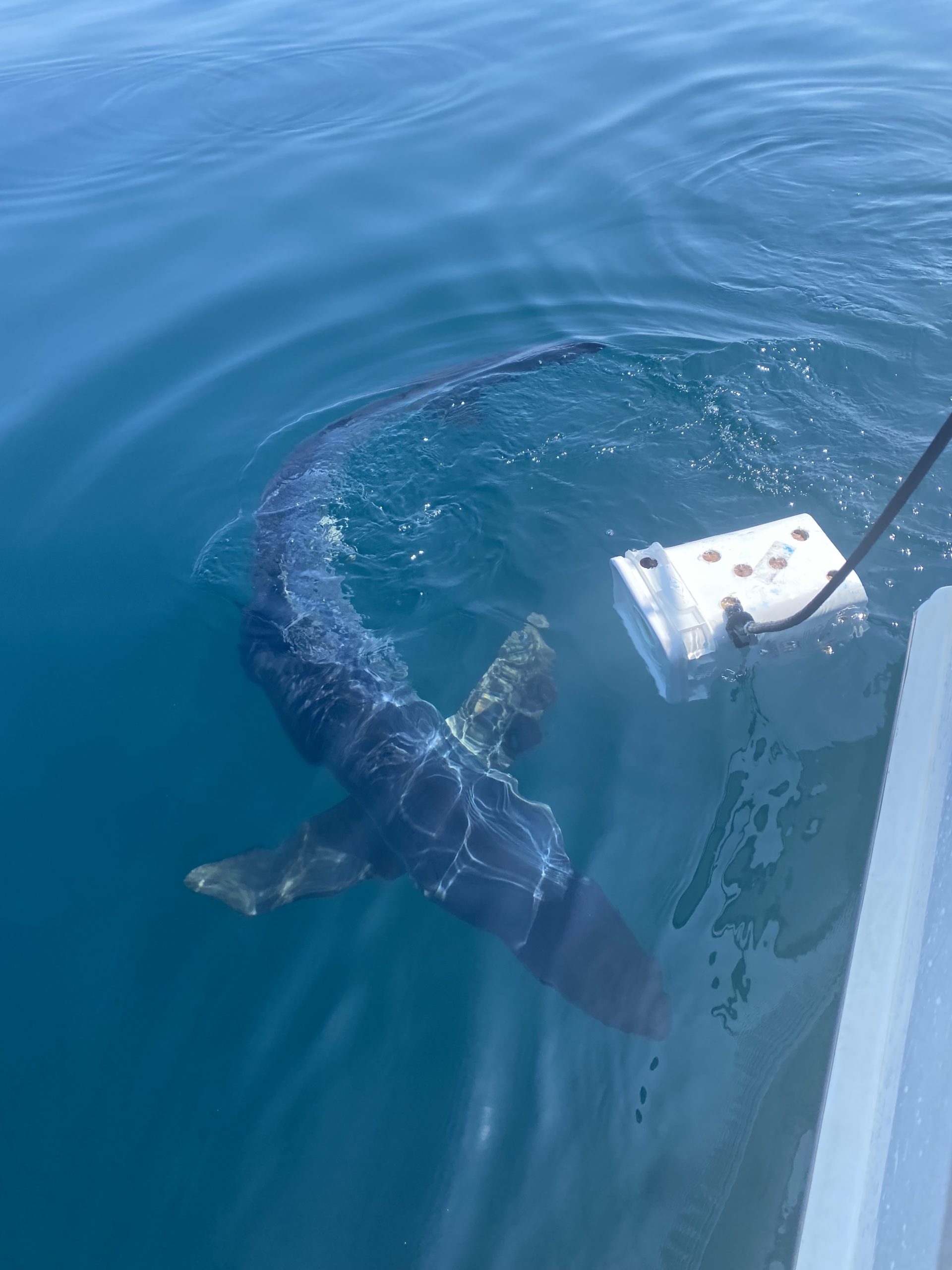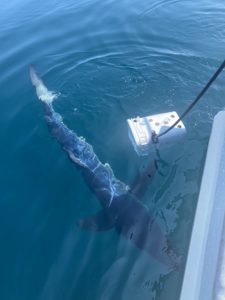
The internship program with Thayer Academy is picking up steam.
Tuesday was a long and eventful day for the BTW team. Our goal was to understand sharks further and ultimately ocean health in the Atlantic waters off of Cape Cod. Our 16 hour day on the water started with a 4:30 am wake-up, to get to Saquatucket Harbor in Harwich, MA for a 6 am departure from the boat launch. Here, we met Captain Nate and journalist Stacey Leasca from Travel + Leisure, who is writing a follow-up to their previous coverage of our work earlier this year. Our first stop was just west of Crab Ledge, where the team deployed the first BRUV and collected eDNA samples using the Niskin bottle. Both equipment pieces are described in our last post here.
Dogfish encounter
The following day, the team watched the footage in awe. We witnessed countless spiny dogfish and smooth dogfish explore and bite at the bluefish-filled bait bag. One shark even wriggled and twisted its body to break it open. Not long after, two more dogfish came, and all three gnawed on the bag to pull out the last bluefish head. The footage showed one of the sharks successfully pulling the entire head out of the bag. The shark swam away with it while numerous other dogfish curiously examined and circled the BRUV in the background.
Whale encounter
After a couple of hours of waiting for something to bite at Crab Ledge, Captain Nate opted to switch locations, searching for more active waters. We traveled about 2 hours south to The Regal Sword while spotting Common Dolphins, Humpback Whales, and Minke Whales along the way. One humpback came straight towards the boat, swimming just 10ft away from us before diving beneath the surface. As soon as we began to drift and chum the water, we immediately spotted two dogfish headed straight towards our bait.
Blue shark encounter
While captivatingly watching the whales, the team patiently awaited a shark. The first shark sighting was a beautiful blue shark that nosed right up to the boat, swimming from one side to the other. The shark came up to the ship to bite at the bluefish carcasses, which were strung on a wireline off to the side. The shark was enormous and feisty, continuously thrashing around, and eventually snapped the wire fishing leader, which came up wholly frayed. However, the team did not give up, and we knew that the scent of chum would be keeping him near the boat.
We set out another rod and reel and waited for him to bite again. Sure enough, within minutes, he came back, and we had him hooked. We took our positions and ‘lined out’ the nearly 10ft (9 ft. 6 in. / 290cm) blue shark next to the boat and quickly took measurements and collected all necessary data. What seemed easy on paper was all the more difficult due to the shark’s spastic movements and energy, which made every single test a challenge as he thrashed about. We tried to hold him still and keep our focus, and were able to complete the workup and safely release him in under 10 minutes.

Credit: Christine de Silva.
Second Blue shark and Mako
The second blue shark came only 45 minutes after the first. At the same time, a smaller mako shark showed up right next to the Blue shark to investigate the bait as well. Despite wanting to catch the mako, the blue shark bit first, and we chose to work him up. This time around, the blue shark was much smaller (just barely over 5 feet) and noticeably calmer than the first. After running through it once, the team felt confident, and each person knew what they needed to do and when. We were prepared and worked fast and efficiently, finishing this work up in under 5 minutes.
Although the mako slipped out of sight, we were happy with our two taggings for the day. After picking up the BRUV just before sunset, the boat drove to the harbor to collect the last set of eDNA samples before heading back to the dock. The entire crew was drenched in cold saltwater as the boat drove straight into the wind and storm, each wave practically engulfing us. Soaked to the core, drained of all energy, but oddly satisfied, we docked and unloaded at 9:45 pm, putting our fantastic 16 hour day to rest.
Edited by Nathan Perisic.
About the Authors
Kate Quigley is an intern for Beneath the Waves at their new lab. She grew up spending her weekends and summers exploring the Chesapeake Bay, where her passion for the ocean began. While kayaking, swimming, and canoeing on the bay, she became exceptionally curious about marine species and the immense amount of biodiversity underwater. During her first open water scuba dive, she encountered two sevengill sharks and has been fascinated with these creatures ever since. When met with the chance to work with sharks at Beneath the Waves, she jumped at the opportunity. She is currently a rising senior at Winston Churchill High School in Potomac, Maryland where she leads the school’s climate club and has implemented a school-wide composting program. In college, she intends to study environmental science and marine biology in hopes of building a sustainable blue economy and solutions for improving ocean conservation efforts.
Eliza Lester is a college graduate with a bachelor’s degree in environmental studies and a passion for wildlife and biodiversity conservation, particularly in marine ecosystems. Since she was a child, she has always felt a serious connection and draw toward animals of all kinds, always entertaining herself with everything our world’s ecosystems have to offer. During the summer before her senior year at Stonehill College she participated in an internship with the New England Coastal Wildlife Alliance on their Southcoast Terrapin Project where she conducted field research & observations as well as protecting nests and tagging Diamondback Terrapins. To fulfill part of her senior capstone project assignment, she did a research paper on how commercial fishing traps affect and harm vulnerable species such as Diamondback Terrapins. The paper was also directed towards finding a solution to the problem of bycatch – discovering ways to create and implement trapping in a way that will both reduce the risk of bycatch as well as how we can use certain types of traps to safely capture threatened species for observation and research. In the past, she never believed that she would be able to pursue her passion for wildlife as a career, but with persistence, passion for this evermore important field and many years of networking, she realized this goal was far from unobtainable. In the summer of 2020, she had the opportunity to go out sharking off of Great Point beach in Nantucket with Elliot Sudal where she got her first up-close look at shark tagging. She sparked conversation with Elliot about their similar passions for behavioral ecology, conservation, and importance of environmental education. Because Elliot was working for Austin at the time, this new connection eventually led her to an introduction to Beneath the Waves and an internship opportunity that she was never expecting.










